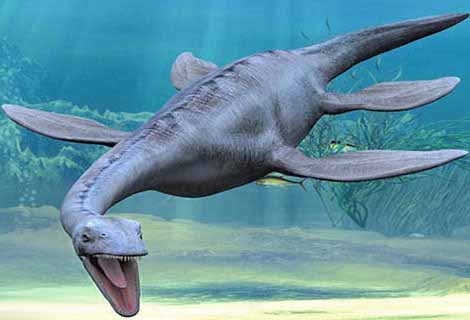

The Loch Ness Monster is a cryptid - a creature whose existence has been suggested but is not recognized by scientific consensus. Nessie, is reputedly a large unknown animal that is said to inhabit Loch Ness in the Scottish Highlands. It is similar to other supposed lake monsters in Scotland and elsewhere, though its description varies from one account to the next. Popular interest and belief in the animal's existence has varied since it was first brought to the world's attention in 1933. Evidence of its existence is anecdotal, with minimal and much-disputed photographic material and sonar readings.
The most common speculation among believers is that the creature represents a line of long-surviving plesiosaurs. The scientific community regards the Loch Ness Monster as a modern-day myth, and explains sightings as including misidentifications of more mundane objects, outright hoaxes, and wishful thinking. Despite this, she remains one of the most famous examples of cryptozoology. The legendary monster has been affectionately referred to by the nickname Nessie since the 1950s.
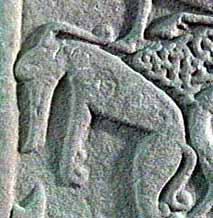
Carvings of this unidentified animal, made by the ancient inhabitants of the Scottish Highlands some 1,500 years ago, are the earliest evidence that Loch Ness harbors a strange aquatic creature. Most Nessie witnesses describe something with two humps, a tail, and a snakelike head. A V-shaped was often mentioned, as well as a gaping red mouth and horns or antennae on the top of the creature's head. Nessie's movements have been studied, and the films and photos analyzed to determine what Nessie might be, if she exists.
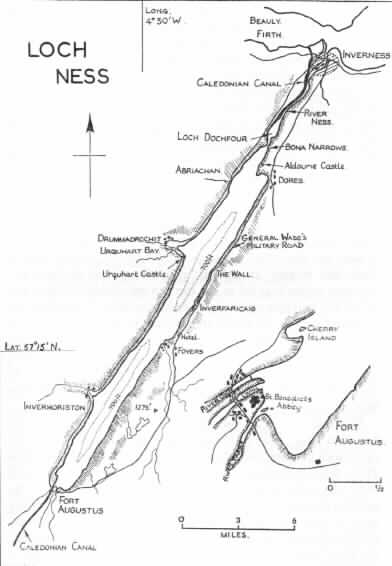
Loch Ness is located in the North of Scotland and is one of a series of interlinked lochs which run along the Great Glen. The Great Glen is a distinctive incision which runs across the country and represents a large geological fault zone. The interlinking was completed in the 19th century following the completion of the Caledonian Canal.
The Great Glen is more than 700 ft (213 m) deep and ice free. It is fed by the Oich and other streams and drained by the Ness to the Moray Firth. It forms part of the Caledonian Canal. By volume, Loch Ness is the largest freshwater lake in Great Britain.
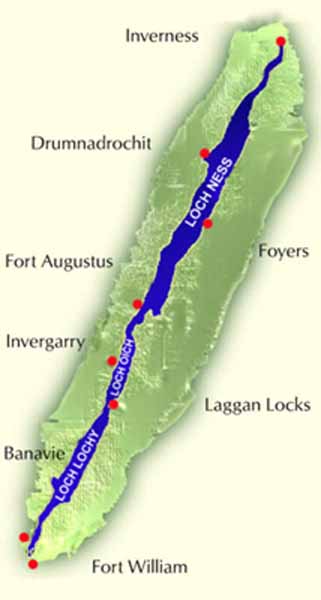
There’s probably no monster in Loch Ness. But we did find one of its best-kept secrets after 90 years CNN - November 11, 2023
The truth is that this is no ordinary lake. Despite its wintry temperatures, Loch Ness never freezes over due to the thermocline effect, which means cooler water sinks and is replaced by warmer water from below.
90 Years Ago, The First Photographic Evidence Of The Loch Ness Monster Was Revealed IFLScience - November 10, 2023
On November 12, 1933, one man allegedly photographed something strange and mysterious lurking in Loch Ness, Scotland. It has now been 90 years since this famous photo appeared to the public, and the frenzy it generated is very much still alive.
August 29, 2023 - To date Nessie remains an enigma as humans are programmed to quest for answers in the search to find out who they are and why they are here. Nessie might be explained as a Cryptid, an alien, an inter-dimensional sentient life form, a hybrid marine animal, or just a figment of someone's imagination. They are never going to find Nessie.
Several reports of possible sightings have been recorded as the biggest Loch Ness Monster hunt in decades ended on Sunday in Scotland. However, no conclusive evidence of the famous beast has yet been found DW - August 28, 2023
The biggest Loch Ness Monster hunt in over half a century has resulted in several reports of possible sightings but nothing conclusive. The evaluation of the data would take a lot of time, the organizers said.
Video: Hundreds join huge search for Loch Ness Monster BBC Science - August 27, 2023
Following analysis, the scientists ruled out the presence of large animals which were said to be behind reports of a monster.
No evidence of a prehistoric marine reptile called a plesiosaur or a large fish such as a sturgeon were found.
Video: Noises Heard In Biggest Hunt For The Loch Ness Monster In 50 Years IFL Science - August 28, 2023
A huge hunt took place over the weekend for Nessie, the beast first "photographed" 89 years ago and which occasionally turns out to be a fish. The team of citizen scientists from around the world searched, among other methods, by watching the surface of the loch for two days, figuring that it would need to come up for air at some point.
Bizarre, Nessie-Like Creature Washes Ashore in Georgia, and Marine Experts Are Mystified Live Science - March 21, 2018
A bizarre, possibly decapitated sea creature with a long tail that washed ashore in southeastern Georgia has mystified marine experts. Is it a dead frilled shark? Or a decayed whale or an oarfish?
Is this where Nessie's been hiding all these years? Daily Mail - January 19, 2015
Fisherman discovers 900-foot-deep trench that would be big enough for the legendary monster and her whole family. In December last year, it was revealed that sightings of the Monster are at their highest in more than a decade, with five people claiming to have spotted the creature in the last year.
The sedimentary rocks which cradle Loch Ness are some of the oldest in the world. The sandstones were originally laid down in warm seas which then comprised Scotland. You would not have recognized the land masses at that time and, surprisingly, Scotland was probably located in the latitude where Australasia exists today.
As part of continental drift the continents very slowly drifted northwards as Scotland became squeezed into the dry center of the super-continent Pangaea. By this time, 250 million years ago, the Great Glen side slip fault, which is home to Lochs Ness, Oich, Lochy and Linnhe, had already been created.
As Scotland crossed the equator it was the time of the dinosaurs and then as the continents began to break up and cluster around the north pole, the great ice ages began. Scottish mountains, which would have been Himalayan in size were gradually worn down to the stumps which you see today.
Scotland was still in the grip of the ice twelve thousand years ago, but the main advances were over and the land was beginning to rebound from being depressed into the mantle. The surface of Loch Ness would have been at a similar elevation to sea level, but detailed and thorough examination of the sediments at the northwest end of the loch show no evidence for any incursion of the sea since the last ice age.
Anything living in Loch Ness today must have arrived from the freezing North Sea up the River Ness after the final retreat of ice, ten to twelve thousand years ago. This automatically eliminates certain Loch Ness monster candidates, primarily the reptiles, amphibians and invertebrates. Today, without the weight of ice, the land has risen and the surface of the loch would naturally stand at about 42 feet (12.8m) above sea level, but during the building of the Caledonian Canal, completed 1822, Telford built a weir at Loch Dochfour SATPIC 1 raising the level of the loch by 9 feet (3m) and saving the necessity for a lot more excavation to make that area navigable. The mean height of the surface of the loch above sea level is now taken as 51 feet (15.5m) although in recent years the wetter winters may have increased the mean somewhat.
When the ice retreated the area would have been an extremely barren landscape. It may be hard to imagine the lack of trees, or even grass, rainfall washing deposits off the hills into the loch. Gradually wind-blown seeds would have introduced vegetation, the first trees being the silver birch which is still here in huge numbers. As part of the Loch Ness Project's Rosetta Project an examination of the sediments has shown that silver birch pollen existed here just after the retreat of ice. Once you have a few grasses and trees the birds and animals would have begun to enter the new habitat. They would bring berries and heavier seeds thus continuing the movement of the Caledonian Forest northwards. Throughout this period the heavier wind-blown seeds like sycamore and ash would have been carried northwards until the Highlands mixed forest was established.
While the loch would gradually become populated with cold-water fish, the land saw a far greater variety of life including wolves, bears, beavers and elk - all extinct here now, although the last wolf in the area was only shot in the nineteenth century. That wolf was known as Altsaigh SATPIC 22 and the name is still used for the burn (stream) which enters the loch from the northern side half way along its length. It was here that Altsaigh was killed.
Mankind entered the Great Glen following the animals. The Picts left their mark throughout the glen. Gradually they were superseded by the Scots who had come across from Scotia (Ireland) around the sixth century, although the "amalgamation" appears to have been relatively peaceful. Certainly there is no implication that the Scots conquered the Picts as they were outnumbered by around 20 to 1. Even today the Picts/Celts represent the major part of the Scottish population. At the beginning of the last millennium the Scots elected their kings and this was the time of Kenneth, Duncan and Macbeth. Interestingly it was a Scottish King, James VI who also became king of England when Elizabeth Tudor died and he unified the countries, conveniently handing Scotland to England on a plate when he moved his court south when becoming James I of England. Today many of us are looking for Scotland to become an independent nation within the European community and, in 1997, a measure of devolution occurred with the creation of the Scottish Parliament.
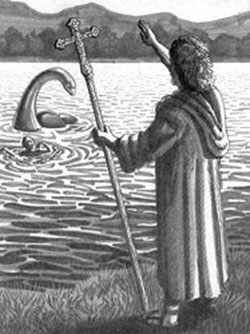
The earliest report of a monster associated with the vicinity of Loch Ness appears in the Life of St. Columba by Adomnan, written in the 7th century. According to Adomnan, writing about a century after the events he described, the Irish monk Saint Columba was staying in the land of the Picts with his companions when he came across the locals burying a man by the River Ness. They explained that the man had been swimming the river when he was attacked by a "water beast" that had mauled him and dragged him under.
They tried to rescue him in a boat, but were able only to drag up his corpse. Hearing this, Columba stunned the Picts by sending his follower Luigne moccu Min to swim across the river. The beast came after him, but Columba made the sign of the Cross and commanded: "Go no further. Do not touch the man. Go back at once." The beast immediately halted as if it had been "pulled back with ropes" and fled in terror, and both Columba's men and the pagan Picts praised God for the miracle.
The oldest manuscript relating to this story was put online in 2012. Believers in the Loch Ness Monster often point to this story, which takes place on the River Ness rather than the loch itself, as evidence for the creature's existence as early as the 6th century. However, sceptics question the narrative's reliability, noting that water-beast stories were extremely common in medieval saints' Lives; as such, Adomnan's tale is likely a recycling of a common motif attached to a local landmark.
According to the sceptics, Adomnan's story may be independent of the modern Loch Ness Monster legend entirely, only becoming attached to it in retrospect by believers seeking to bolster their claims. In an article for Cryptozoology, A. C. Thomas notes that even if there were some truth to the story, it could be explained rationally as an encounter with a walrus or similar creature that had swum up the river. R. Binns acknowledges that this account is the most serious of various alleged early sightings of the monster, but argues that all other claims of monster sightings prior to 1933 are highly dubious and do not prove that there was a tradition of the monster before this date.
Modern interest in the monster was sparked by a sighting on 22 July 1933, when George Spicer and his wife saw 'a most extraordinary form of animal' cross the road in front of their car. They described the creature as having a large body (about 4 feet (1.2 m) high and 25 feet (7.6 m) long), and long, narrow neck, slightly thicker than an elephant's trunk and as long as the 10-12-foot (3-4 m) width of the road; the neck had undulations in it. They saw no limbs, possibly because of a dip in the road obscuring the animal's lower portion. It lurched across the road towards the loch 20 yards (20 m) away, leaving only a trail of broken undergrowth in its wake.
In August 1933 a motorcyclist named Arthur Grant claimed to have nearly hit the creature while approaching Abriachan on the north-eastern shore, at about 1 a.m. on a moonlit night. Grant claimed that he saw a small head attached to a long neck, and that the creature saw him and crossed the road back into the loch. A veterinary student, he described it as a hybrid between a seal and a plesiosaur. Grant said he dismounted and followed it to the loch, but only saw ripples. Some believe this story was intended as a humorous explanation of a motorcycle accident.
Sightings of the monster increased following the building of a road along the loch in early 1933, bringing both workmen and tourists to the formerly isolated area Sporadic land sightings continued until 1963, when film of the creature was shot in the loch from a distance of 4 kilometres. Because of the distance at which it was shot, it has been described as poor quality.
In 1938, Inverness Shire Chief Constable William Fraser wrote a letter stating that it was beyond doubt the monster existed. His letter expressed concern regarding a hunting party that had arrived armed with a specially-made harpoon gun and were determined to catch the monster "dead or alive". He believed his power to protect the monster from the hunters was "very doubtful". The letter was released by the National Archives of Scotland on 27 April 2010.
In May 1943, C. B. Farrel of the Royal Observer Corps was supposedly distracted from his duties by a Nessie sighting. He claimed to have been about 250 yards (230 m) away from a large-eyed, 'finned' creature, which had a 20-to-30-foot (6 to 9 m) long body, and a neck that protruded about 4-5 feet (1.2-1.5 m) out of the water
In December 1954 a strange sonar contact was made by the fishing boat Rival III. The vessel's crew observed sonar readings of a large object keeping pace with the boat at a depth of 480 feet (146 m). It was detected traveling for half a mile (800 m) in this manner, before contact was lost, but then found again later. Many sonar attempts had been made previously, but most were either inconclusive or negative.
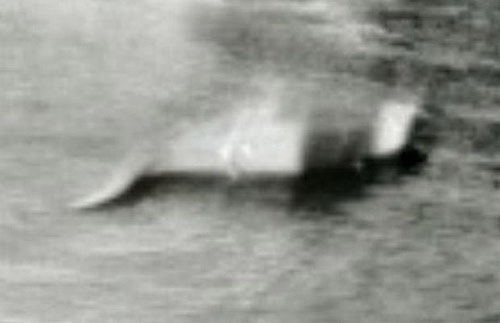
On 12 November 1933, Hugh Gray was walking along the loch after church when he spotted a substantial commotion in the water. A large creature rose up from the lake. Gray took several pictures of it, but only one of them showed up after they were developed. This image appeared to show a creature with a long tail and thick body at the surface of the loch. The image is blurred suggesting the animal was splashing. Four stumpy-looking objects on the bottom of the creature's body might possibly be a pair of appendages, such as flippers. Although critics have claimed that the photograph is of a dog swimming towards the camera (possibly carrying a stick), researcher Roland Watson rejects this interpretation and suggests there is an eel-like head on the right side of the image. This picture is the first known image allegedly taken of the Loch Ness Monster.
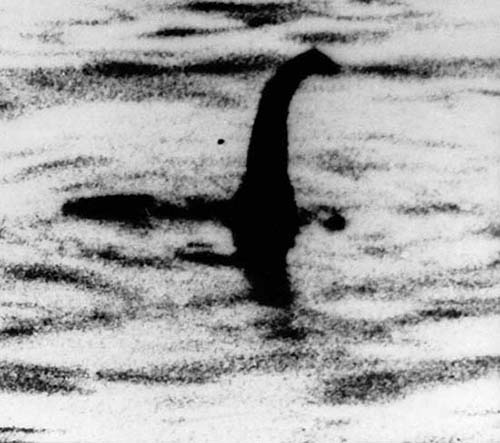
The "Surgeon's Photograph" purported to be the first photo of a "head and neck". Dr. Wilson claimed he was looking at the loch when he saw the monster, so grabbed his camera and snapped five photos. After the film was developed, only two exposures were clear. The first photo (the more publicized one) shows what was claimed to be a small head and back. The second one, a blurry image, attracted little publicity because it was difficult to interpret what was depicted.
The image was revealed as a fake in The Sunday Telegraph dated 7 December 1975. Supposedly taken by Robert Kenneth Wilson, a London gynaecologist, it was published in the Daily Mail on 21 April 1934. Wilson's refusal to have his name associated with the photograph led to it being called "Surgeon's Photograph".
The strangely small ripples on the photo fit the size and circular pattern of small ripples as opposed to large waves when photographed up close. Analysis of the original uncropped image fostered further doubt. In 1993, the makers of Discovery Communications's documentary Loch Ness Discovered analysed the uncropped image and found a white object was visible in every version of the photo, implying it was on the negative. It was believed to be the cause of the ripples, as if the object was being towed, though it could not be ruled out as a blemish in the negative. Additionally, one analysis of the full photograph revealed the object was quite small, only about 60 to 90 cm (2 to 3 ft) long. However, analyses of the size of the photograph have been inconsistent.
In 1979 it was claimed to be a picture of an elephant (see below). Other sceptics in the 1980s argued the photo was that of an otter or a diving bird, but after Christian Spurling's confession most agree it was what Spurling claimed - a toy submarine with a sculpted head attached.
Details of how the photo was accomplished were published in the 1999 book, Nessie - the Surgeon's Photograph Exposed, that contains a facsimile of the 1975 article in The Sunday Telegraph. Essentially, it was a toy submarine bought from F.W. Woolworths with a head and neck made of plastic wood, built by Christian Spurling, the son-in-law of Marmaduke Wetherell, a big game hunter who had been publicly ridiculed in the Daily Mail, the newspaper that employed him.
Spurling claimed that to get revenge, Marmaduke Wetherell committed the hoax, with the help of Chris Spurling (a sculpture specialist), his son Ian Marmaduke, who bought the material for the fake, and Maurice Chambers (an insurance agent), who asked surgeon Robert Kenneth Wilson to offer the pictures to the Daily Mail. The hoax story is disputed by Henry Bauer, who claims this debunking is evidence of bias, and asks why the perpetrators did not reveal their plot earlier to embarrass the newspaper.
Tim Dinsdale also disputes the claim of this photograph as a hoax in his book Loch Ness Monster. He claims that he studied the photograph so often and from many different angles that he was able to discern objects that prove the photograph is not a hoax. He states "upon really close examination, there are certain rather obscure features in the picture which have a profound significance."
Two of the obscure features are: a solid object breaking the surface to the right of the neck, and to the left and behind the neck there is another mark of some sort, Dinsdale states. After making this claim Dinsdale discusses that these objects are too hard to identify, but that just proves that they could be part of the monster. According to Dinsdale either the objects are part of a very subtle fake or genuinely part of the monster.
Another object that he points out to prove the photograph is not a fake is the vague smaller ripples that are behind the neck, which seem to have been caused after the neck broke the surface. Dinsdale emphatically states that this is a part of the animal underwater behind the neck. His reasons suggest that it is possible that the photograph is not a fake.
Alastair Boyd, one of the researchers who uncovered the hoax, argues that the Loch Ness Monster is real, and that although the famous photo was hoaxed, that does not mean that all the photos, eyewitness reports, and footage of the monster were as well. He asserts that he too had a sighting and also argues that the hoaxed photo is not a good reason to dismiss eyewitness reports and other evidence.
In 1938, G. E. Taylor, a South African tourist, filmed something in the loch for three minutes on 16 mm color film, which was in the possession of Maurice Burton. Burton refused to show the film to Loch Ness investigators (such as Peter Costello or the Loch Ness Investigation Bureau). A single frame was published in his book The Elusive Monster; before he retired. Roy P. Mackal, a biologist and cryptozoologist, declared the frame was "positive evidence". Later, it was shown also to the National Institute of Oceanography, now known as the National Oceanography Centre, Southampton.
In 1960, aeronautical engineer Tim Dinsdale filmed a hump crossing the water leaving a powerful wake. Dinsdale allegedly spotted the animal on his last day hunting for it, and described the object as reddish with a blotch on its side. When he mounted his camera the object started to move and said that he shot 40 feet of film. JARIC declared that the object was "probably animate". Others were sceptical, saying that the "hump" cannot be ruled out as being a boat, and claimed that when the contrast is increased a man can be seen in a boat.
In 1993 Discovery Communications made a documentary called Loch Ness Discovered that featured a digital enhancement of the Dinsdale film. A computer expert who enhanced the film noticed a shadow in the negative that was not very obvious in the positive. By enhancing and overlaying frames, he found what appeared to be the rear body of a creature underwater. He commented that "Before I saw the film, I thought the Loch Ness Monster was a load of rubbish. Having done the enhancement, I'm not so sure". Some have countered this finding by saying that the angle of the film from the horizontal along with sun's angle on that day made shadows underwater unlikely. Others pointed out that the darker water is undisturbed water that was only coincidentally shaped like body. The same source also says that there might be a smaller object (hump or head) in front of the hump causing this.
On 26 May 2007, Gordon Holmes, a 55-year-old lab technician, captured video of what he said was "this jet black thing, about 45 feet (14 m) long, moving fairly fast in the water." Adrian Shine, a marine biologist at the Loch Ness 2000 centre in Drumnadrochit, described the footage as among "the best footage he has ever seen." BBC Scotland broadcast the video on 29 May 2007. STV News' North Tonight aired the footage on 28 May 2007 and interviewed Holmes. In this feature, Adrian Shine of the Loch Ness Centre was also interviewed and suggested that the footage showed an otter, seal or water bird.
Holmes's credibility has been doubted by an article on the Cryptomundo website, which states that he has a history of reporting sightings of cryptozoological creatures, and sells a self-published book and DVD claiming evidence for fairies. His video also has no other objects for size comparison. The MonsterQuest team investigated this video as well in their TV episode "Death of Loch Ness", where they examine evidence that Nessie has died, as well as other photos. In this documentary, Holmes asserts he spotted two creatures. A CNN news report showed the footage and an interview with Gordon Holmes. Joe Nickell has suggested that this footage shows one or more otters, swimming in the loch.
On 24 August 2011, Marcus Atkinson, a local Loch Ness boat skipper, photographed a sonar image of a long 5 ft wide unidentified object which was apparently following his boat for two minutes at a depth of 75 ft. Atkinson ruled out the possibility of any small fish or seal being what he believed to be the Loch Ness Monster.
In April 2012, a scientist from the National Oceanography Centre said that this image is a bloom of algae and zooplankton. However, Roland Watson, a cryptozoologist and Loch Ness Monster researcher, has criticized this analysis, stating that the object in the image is very unlikely to be a bloom of algae and zooplankton, since algae needs sunlight to grow, and the waters of Loch Ness are very dark, and nearly devoid of sunlight, 75 feet down.
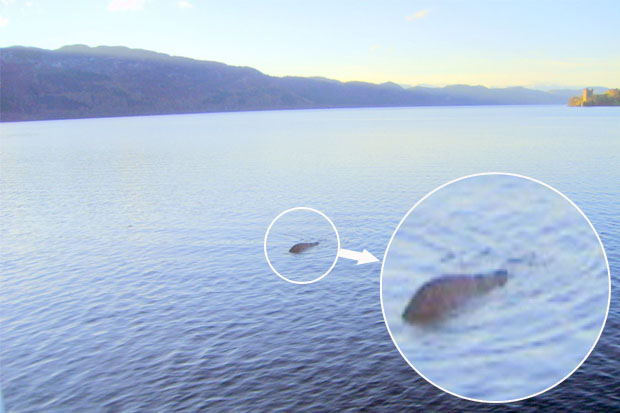
On 3 August 2012, skipper George Edwards published a photograph he claims to be "The most convincing Nessie photograph ever", which he claimed to have taken on 2 November 2011. Edwards' photograph consists in a hump out of the water which, according to him, remained so for five to ten minutes.
The Daily Mail reports that Edward had the photograph independently verified by specialists such as a Loch Ness Monster sighting devotee and a group of US military monster experts. Edwards spends 60 hours per week on the loch aboard his boat, Nessie Hunter IV, in which he takes tourists for a ride on the lake, and claims to have searched for the Loch Ness monster for 26 years. Said Edwards, "In my opinion, it probably looks kind of like a manatee, but not a mammal. When people see three humps, they’re probably just seeing three separate monsters."
However, other researchers of the Loch Ness phenomena have questioned the authenticity of the photograph. A subsequent investigation by Loch Ness researcher, Steve Feltham, suggests that the object in the water is in fact a fibreglass hump used previously in a National Geographic documentary which Edwards had participated in.
Researcher Dick Raynor has also questioned Edward's claims about finding a deeper bottom to Loch Ness, which he refers to as "Edwards Deep". He also found inconsistencies between Edwards' claims of the location and conditions of the photograph and the actual location and weather conditions of that day. Additionally, Raynor also stated that Edwards had previously told him he had faked a photograph in 1986, which he had promoted as genuine in the National Geographic documentary.
Loch Ness Monster? Skipper George Edwards Has 'Best Ever' Shot Of Elusive Nessie Huffington Post - March 8, 2012
A sailor who has spent 26 years searching for the Loch Ness Monster has what he believes is the best ever picture taken of the elusive beast. George Edwards spends around 60 hours a week patrolling the famous loch, taking tourists out on his boat Nessie Hunter IV, and has led numerous hunts for the fabled created over the years. But this image is the one that's convinced him that there really is a monster or even monsters - out there. It shows a mysterious dark hump moving in the water towards Urquhart Castle.
Having read the book by Gould, Edward Mountain decided to finance a proper watch. Twenty men with binoculars and cameras positioned themselves around the Loch from 9 am to 6 pm, for five weeks starting 13 July 1934. They took 21 photographs, though none was considered conclusive. Captain James Fraser was employed as a supervisor, and remained by the Loch afterwards, taking cine film (which is now lost) on 15 September 1934. When viewed by zoologists and professors of natural history it was concluded that it showed a seal, possibly a grey seal.
The Loch Ness Phenomena Investigation Bureau (LNPIB) was a UK-based society formed in 1962 by Norman Collins, R. S. R. Fitter, David James, MP, Peter Scott and Constance Whyte "to study Loch Ness to identify the creature known as the Loch Ness Monster or determine the causes of reports of it." It later shortened the name to Loch Ness Investigation Bureau (LNIB). It closed in 1972. The society had an annual subscription charge, which covered administration. Its main activity was for groups of self-funded volunteers to watch the loch from various vantage points, equipped with cine cameras with telescopic lenses. From 1965 to 1972 it had a caravan camp and main watching platform at Achnahannet, and sent observers to other locations up and down the loch. According to the 1969 Annual Report of the Bureau, it had 1,030 members, of whom 588 were from the UK.
Professor D. Gordon Tucker, chairman of the Department of Electronic and Electrical Engineering at the University of Birmingham, England, volunteered his services as a sonar developer and expert at Loch Ness in 1968. The gesture was part of a larger effort helmed by the LNPIB from 1967 to 1968 and involved collaboration between volunteers and professionals in various fields. Tucker had chosen Loch Ness as the test site for a prototype sonar transducer with a maximum range of 800 m (2,600 ft).
The device was fixed underwater at Temple Pier in Urquhart Bay and directed towards the opposite shore, effectively drawing an acoustic 'net' across the width of Ness through which no moving object could pass undetected. During the two-week trial in August, multiple animate targets 6 m (20 ft) in length were identified ascending from and diving to the loch bottom. Analysis of diving profiles ruled out air-breathers because the targets never surfaced or moved shallower than midwater. A brief press release by LNPIB and associates touched on the sonar data and drew to a close the 1968 effort.
The answer to the question of whether or not unusual phenomena exist in Loch Ness, Scotland, and if so, what their nature might be, was advanced a step forward during 1968, as a result of sonar experiments conducted by a team of scientists under the direction of D. Gordon Tucker... Professor Tucker reported that his fixed beam sonar made contact with large moving objects sometimes reaching speeds of at least 10 knots (19 km/h; 12 mph). He concluded that the objects are clearly animals and ruled out the possibility that they could be ordinary fish.
He stated: "The high rate of ascent and descent makes it seem very unlikely that they could be fish, and fishery biologists we have consulted cannot suggest what fish they might be. It is a temptation to suppose they might be the fabulous Loch Ness monsters, now observed for the first time in their underwater activities!"
In 1969 Andrew Carroll, field researcher for the New York Aquarium in New York City, proposed a mobile sonar scan operation at Loch Ness. The project was funded by the Griffis foundation (named for Nixon Griffis, then a director of the aquarium). This was the tail-end (and most successful portion) of the LNPIB's 1969 effort involving submersibles with biopsy harpoons. The trawling scan, in Carroll's research launch Rangitea, took place in October. One sweep of the loch made contact with a strong, animate echo for nearly three minutes just north of Foyers. The identity of the contact remains a mystery. Later analysis determined that the intensity of the returning echo was twice as great as that expected from a 10-foot (3 m) pilot whale. On returning to the University of Chicago, biologist Roy Mackal and colleagues subjected the sonar data to greater scrutiny and confirmed dimensions of 20 feet (6 m).
Earlier submersible work had yielded dismal results. Under the sponsorship of World Book Encyclopedia, pilot Dan Taylor deployed the Viperfish at Loch Ness on 1 June 1969. His dives were plagued by technical problems and produced no new data. The Deep Star III built by General Dynamics and an unnamed two-man submersible built by Westinghouse were scheduled to sail but never did. It was only when the Pisces arrived at Ness that the LNPIB obtained new data. Owned by Vickers, Ltd., the submersible had been rented out to produce The Private Life of Sherlock Holmes, a film featuring a dummy Loch Ness Monster.
When the dummy monster broke loose from the Pisces during filming and sank to the bottom of the loch, Vickers executives capitalised on the loss and 'monster fever' by allowing the sub to do a bit of exploring. During one of these excursions, the Pisces picked up a large moving object on sonar 200 feet (60 m) ahead and 50 feet (15 m) above the bottom of the loch. Slowly the pilot closed to half that distance but the echo moved rapidly out of sonar range and disappeared.
During the so-called "Big Expedition" of 1970, Roy Mackal, a biologist who taught for 20 years at the University of Chicago, devised a system of hydrophones (underwater microphones) and deployed them at intervals throughout the loch. In early August a hydrophone assembly was lowered into Urquhart Bay and anchored in 700 feet (210 m) of water.
Two hydrophones were secured at depths of 300 and 600 feet (180 m). After two nights of recording, the tape (sealed inside a 44 gallon drum along with the system's other sensitive components) was retrieved and played before an excited LNPIB. "Bird-like chirps" had been recorded, and the intensity of the chirps on the deep hydrophone suggested they had been produced at greater depth. In October "knocks" and "clicks" were recorded by another hydrophone in Urquhart Bay, indicative of echolocation. These sounds were followed by a "turbulent swishing" suggestive of the tail locomotion of a large aquatic animal.
The knocks, clicks and resultant swishing were believed were the sounds of an animal echo-locating prey before moving in for the kill. The noises stopped whenever craft passed along the surface of the loch near the hydrophone, and resumed once the craft reached a safe distance. In previous experiments, it was observed that call intensities were greatest at depths less than 100 feet (30 m).
Members of the LNPIB decided to attempt communication with the animals producing the calls by playing back previously recorded calls into the water and listening via hydrophone for results, which varied greatly. At times the calling patterns or intensities changed, but sometimes there was no change at all. Mackal noted that there was no similarity between the recordings and the hundreds of known sounds produced by aquatic animals.
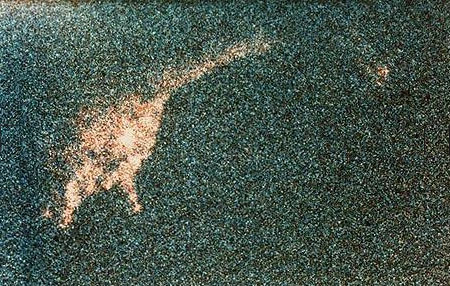
Robert Rines Britain as a cryptozoologist used some of his inventions to try to prove the existence of the Loch Ness Monster Telegraph.co.uk - November 4, 2009
In the early 1970s, a group of people led by Robert H. Rines obtained some underwater photographs. Two were rather vague images, perhaps of a rhomboid flipper (though others have dismissed the image as air bubbles or a fish fin). The alleged flipper was photographed in different positions, indicating movement.
On the basis of these photographs, British naturalist Peter Scott announced in 1975 that the scientific name of the monster would henceforth be Nessiteras rhombopteryx (Greek for "The Ness monster with diamond-shaped fin"). Scott intended that this would enable Nessie to be added to a British register of officially protected wildlife. Scottish politician Nicholas Fairbairn pointed out that the name was an anagram for "Monster hoax by Sir Peter S".
The underwater photos were reportedly obtained by painstakingly examining the loch depths with sonar for unusual underwater activity. Rines knew the water was murky and filled with floating wood and peat, so he took precautions to avoid it. A submersible camera with an affixed, high-powered flood light was deployed to record images below the surface. If he detected anything on the sonar, he would turn the lights on and take some pictures. Several of the photographs, despite their obviously murky quality, did indeed seem to show an animal resembling a plesiosaur in various positions and lightings.
One photograph appeared to show the head, neck and upper torso of a plesiosaur-like animal. After two distinct sonar contacts were made, the strobe light camera photographed two large lumps in the water, suggesting there to be two large animals living in the loch. Another photo seemed to depict a horned "gargoyle head", consistent to that of several sightings of the monster. Sceptics point out that several years later, a log was filmed underwater which bore a striking resemblance to the gargoyle head.
A few close-ups of what might be the creature's diamond-shaped fin were taken, with the "fin" in different positions, as though the creature was moving, but after some time it came to be known that the "flipper photograph" was highly enhanced and retouched compared with the original image. The Museum of Hoaxes shows the original unenhanced photo. Team member Charles Wyckoff claimed that someone retouched the photo to superimpose the flipper, and that the original enhancement showed a much smaller flipper. No one is sure how the original came to be altered.
On 8 August 1972, Rines' Raytheon DE-725C sonar unit, operating at a frequency of 200 kHz and anchored at a depth of 35 feet (11 m), identified a moving target (or targets) estimated by echo strength to be 20 to 30 feet (6 to 9 m) in length. Specialists from Raytheon, Simrad (now Kongsberg Maritime), and Hydroacoustics, Inc.; Marty Klein of MIT and Klein Associates (a producer of side scan sonar); and Dr. Ira Dyer of MIT's Department of Ocean Engineering were all on hand to examine the data. Further, P. Skitzki of Raytheon suggested that the data showed a protuberance, 10 feet (3 m) in length, projecting from one of the echoes. Mackal proposed that the shape was a "highly flexible laterally flattened tail" or the misinterpreted return from two animals swimming together.
In 2001, the Robert Rines' Academy of Applied Science videoed a powerful V-shaped wake traversing the still water on a calm day. The AAS also videotaped an object on the floor of the loch resembling a carcass, found marine clam-shells and a fungus-like organism not normally found in fresh water lochs, which they suggest gives some connection to the sea and a possible entry for Nessie.
In 2008, Rines theorized that the monster may have become extinct, citing the lack of significant sonar readings and a decline in eyewitness accounts. Rines undertook one last expedition to look for remains of the monster, using sonar and underwater camera in an attempt to find a carcass. Rines believed that the animals may have failed to adapt to temperature changes as a result of global warming.
In 1987, Operation Deepscan took place. Twenty-four boats equipped with echosounder equipment were deployed across the whole width of the loch and they simultaneously sent out acoustic waves. BBC News reported that the scientists had made sonar contact with a large unidentified object of unusual size and strength. The researchers decided to return to the same spot and re-scan the area. After analysing the echosounder images, it seemed to point to debris at the bottom of the loch, although three of the pictures were of moving debris. Shine speculates that they could be seals that got into the loch, since they would be of about the same magnitude as the objects detected.
Darrell Lowrance, sonar expert and founder of Lowrance Electronics, donated a number of echosounder units used during Operation Deepscan. After examining the echogram data, specifically a sonar return revealing a large moving object near Urquhart Bay at a depth of 600 feet (180 m), Lowrance said: "There's something here that we don't understand, and there's something here that's larger than a fish, maybe some species that hasn't been detected before. I don't know."
In 1993 Discovery Communications began to research the ecology of the loch. The study did not focus entirely on the monster, but on the loch's nematodes (of which a new species was discovered) and fish. Expecting to find a small fish population, the researchers caught twenty fish in one catch, increasing previous estimates of the loch's fish population about ninefold.
Using sonar, the team encountered a kind of underwater disturbance (called a seiche) due to stored energy (such as from a wind) causing an imbalance between the loch's warmer and colder layers (known as the thermocline). While reviewing printouts of the event the next day, they found what appeared to be three sonar contacts, each followed by a powerful wake. These events were later shown on a program called Loch Ness Discovered, in conjunction with analyses and enhancements of the 1960 Dinsdale Film, the Surgeon's Photo, and the Rines Flipper Photo.
In 2003, the BBC sponsored a full search of the Loch using 600 separate sonar beams and satellite tracking. The search had enough resolution to pick up a small buoy. No animal of any substantial size was found whatsoever and despite high hopes, the scientists involved in the expedition admitted that this essentially proved the Loch Ness monster was only a myth.
A variety of explanations have been postulated over the years to account for sightings of the Loch Ness Monster. These may be categorized as: misidentifications of common animals; misidentifications of inanimate objects or effects; reinterpretations of traditional Scottish folklore; hoaxes; and exotic species of large animals.
Most accounts of Nessie's appearance, including historical ones, indicate a creature resembling the long-extinct plesiosaur. Actual fossil evidence for this Mesozoic creature shows it to have been physically large, with a long neck and tiny head, with flippers for propulsion. The alleged connection of this creature with the Loch Ness monster has made it a popular topic in the field of cryptozoology.
However, most scientists suggest the idea that the Loch Ness Monster is a remnant of the Mesozoic era is highly unlikely; there would need to be a breeding colony of such creatures for there to have been any long-term survival, and coupled with the fact that plesiosaurs needed to surface to breathe, this would result in far more frequent sightings than have actually been reported (some animals, such as crocodiles, that need to breathe air intermittently, can stay underwater for extended periods of time by remaining still and conserving its oxygen supply).
Many biologists also argue Loch Ness is not large or productive enough to support even a small family of these creatures. Moreover, the loch was created as the result of geologically recent glaciation and was frozen solid during recent ice-ages.
Other sightings, however, do not fit the plesiosaur description or even a water-bound creature: In April 1923, Alfred Cruickshank claimed to have seen a creature 3 m to 3.5 m long, with an arched back and four elephant-like feet cross the road before him as he was driving. Other sightings report creatures more similar to camels or horses.
Theories as to the exact nature of the Loch Ness Monster sightings are varied: pareidolia or misidentification of seals, fish, logs, mirages, seiches, and light distortion, crossing of boat wakes, or unusual wave patterns.
Very large sturgeon have been found in inland streams close to Loch Ness, and due to sturgeons' size and unusual appearance, one could easily be mistaken for a monster by someone not familiar with it.
A recent theory postulates that the "monster" is actually nothing more than bubbling and disruptions in the water caused by minor volcanic activity at the bottom of the loch. This latter argument is supported to a minor degree by a correlation between tectonic motion and reported sightings.
Some researchers, notably John Keel, F.W. Holiday, A. Winchester Beebe (otherwise known as the Buffalo musician Nikki Christmas), and Jon-Erik Beckjord, postulate that there are no anomalous physical creatures within the loch. Because of the complete absence of physical evidence, these researchers argue that many of the reported sightings can be attributed to hoaxes or misidentification of conventional creatures and objects. They also argue that a small residue of reported Loch sightings could be paranormal, or supernatural in nature, i.e., having a temporal semi-physical construction, similar to other anomalous phenomena such as Bigfoot and UFOs. Read more...